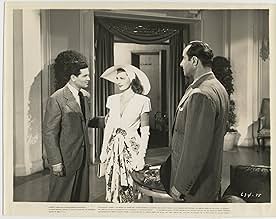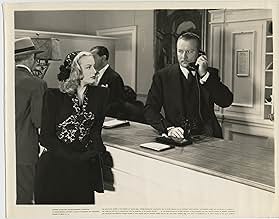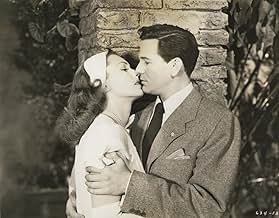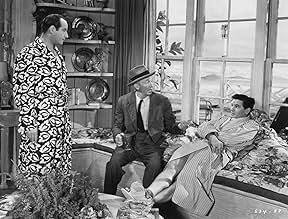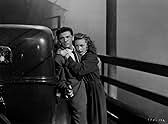ÉVALUATION IMDb
7,1/10
2,1 k
MA NOTE
Ajouter une intrigue dans votre langueEx-GI Nick Blake gets involved in a scheme to fleece a rich, young widow, but finds himself falling for her, much to the displeasure of his racketeer cohorts.Ex-GI Nick Blake gets involved in a scheme to fleece a rich, young widow, but finds himself falling for her, much to the displeasure of his racketeer cohorts.Ex-GI Nick Blake gets involved in a scheme to fleece a rich, young widow, but finds himself falling for her, much to the displeasure of his racketeer cohorts.
Richard Erdman
- Bellboy at The Marwood Arms
- (as Dick Erdman)
Fred Kelsey
- Railroad Conductor
- (scenes deleted)
Robert Arthur
- Bellhop
- (uncredited)
John Barton
- Barfly
- (uncredited)
Ted Billings
- Barfly
- (uncredited)
Jack Chefe
- Hotel Waiter
- (uncredited)
Adrian Droeshout
- Bar Patron
- (uncredited)
Avis en vedette
Home from service in World War II, roughly handsome hotshot gambler John Garfield (as Nick Blake) tries to reconnect with sexy blonde Faye Emerson (as Toni Blackburn), but learns she's used up his dough, and hooked up with another stud. Discouraged, he moves to Los Angeles, with fawning companion George Tobias (as Al Doyle). There, con artists Walter Brennan (as Pop Gruber) and George Coulouris (as Doc Ganson) persuade Mr. Garfield to bilk $2,000,000 out of wealthy widow Geraldine Fitzgerald (as Gladys Halvorsen). "She's a dish," says Tobias, and Garfield proceeds predictably...
Probably due to its release amid so many other great Garfield films, "Nobody Lives Forever" seems to have gotten lost in the shuffle. It labors somewhat, during the last act, as the production seeks to take full advantage of a moody setting. Still, this is an excellent "film noir" from the forties. A perfect lead, Garfield is magnetically smooth. He receives great assist from Jean Negulesco's stylishly hiccuping direction, Adolph Deutsch's sweet musical score, Arthur Edeson's black-and-white camera, and the usual suspects at Warner Bros. And, the players breathe some nuance into W.R. Burnett's fine script.
******* Nobody Lives Forever (11/1/46) Jean Negulesco ~ John Garfield, Geraldine Fitzgerald, Walter Brennan, Faye Emerson
Probably due to its release amid so many other great Garfield films, "Nobody Lives Forever" seems to have gotten lost in the shuffle. It labors somewhat, during the last act, as the production seeks to take full advantage of a moody setting. Still, this is an excellent "film noir" from the forties. A perfect lead, Garfield is magnetically smooth. He receives great assist from Jean Negulesco's stylishly hiccuping direction, Adolph Deutsch's sweet musical score, Arthur Edeson's black-and-white camera, and the usual suspects at Warner Bros. And, the players breathe some nuance into W.R. Burnett's fine script.
******* Nobody Lives Forever (11/1/46) Jean Negulesco ~ John Garfield, Geraldine Fitzgerald, Walter Brennan, Faye Emerson
This is a great film about an Ex-Gi named Nick Blake, (John Garfield) who goes back to New York City and gets back with his gal, Toni Blackburn, (Faye Emerson) who is a very attractive blonde gal. Nick soon finds out that the $50,000 dollars he gave her is gone and was given to her new boyfriend. Nick manages to get his money back and heads to Los Angeles and starts his con-artist career all over again. Nick travels with his sidekick, Al Doyle, (George Tobias) who is his bodyguard and good friend. Nick meets up with an old buddy of his named Pop Gruber, (Walter Brennan) who tells him about a very rich woman who is a widow and named Gladys Halvorsen, (Geraldine Fitzgerald). Gladys has a fortune of 2 million dollars and Nick decides to become much closer to this gal. This is when the story gets very involved and you will never be able to figure out how this film will end. Faye Emerson was the wife of famous band leader, Skitch Henderson in real life and she gave a great supporting role. Enjoyed the great acting by veteran actor Walter Brennan and last but least, John Garfield.
Many films from the mid-forties deal with men struggling to readjust to their civilian lives after their wartime service. NOBODY LIVES FOREVER offers a twist: the hero's pre-war career was as a successful con artist. He doesn't have any trouble getting his job back, but does he still want it? World War II is a source of anxiety and moral confusion in many postwar noirs, but this film (set during the war) suggests that a stint with Uncle Sam can straighten out a crooked guy.
In contrast to the convoluted plots so common in noir, this is a simple story. Just out of the army, Nick Blake (John Garfield) returns to New York to find his girlfriend has given the money he left in her keeping to another man. After clearing up that little business, he takes off for Los Angeles, where he is talked into fleecing a rich widow, Gladys Halvorson (Geraldine Fitzgerald.) Guess what? He falls for her and wants out, but has to deal with his vengeful accomplices. The plot is unoriginal but also foolproof, and the film's leisurely pace and rich characterizations are the primary appeal, evoking a raffish, Runyonesque world. Leading the troupe of colorful character actors is George Tobias as Blake's sidekick Al Doyle, who doesn't do much except tag along for the ride, cracking wise in thick New Yorkese and complaining bitterly when he realizes Nick has "gone overboard for this tomato." Walter Brennan is Pop Gruber, Nick's boyhood mentor in crime, now down on his luck and scraping a living with a telescope, selling "the moon and stars for a dime" and picking the pockets of his drunken customers. Then there's cadaverous, sinister George Colouris as Doc, a has-been con man consumed by jealousy of Nick. Even the smallest charactersfrom an ex-jockey bellboy to the counterman in an all-night diner who can't stand to hear the words "java" or "pal"add flavor; they're a great bunch of "cheap, hungry chiselers." Richard Gaines (Jean Arthur's fiancé, Mr. Pendergast, in THE MORE THE MERRIER) is also amusing as Manning, the widow's business manager, whose only interest in life is golf. Only Faye Emerson, as the nightclub singer who betrayed Nick while he was overseas and keeps turning up for vague plot purposes, misfires; she sings well, but she's a little too bony, toothy and disgruntled for a femme fatale.
When someone suggests that after his sabbatical in the army Nick might not be up to conning the widow, he snaps scornfully, "For me that would be like turning over in bed." The same is true for Garfield playing this morally-conflicted-tough-guy rolebut he never lets you feel he's just going through the motions. His performance is split between his "Jewish Jimmy Cagney" persona, spitting out lines like, "Come up with a rod and I'll make you eat it," and his sexy romancer mode. When he turns on the charm, his mark starts to melt like a snowman under a sun lamp. (I can sympathize, being a pushover for Garfield myself.) Geraldine Fitzgerald is lovely and gracious, with a frail, childlike innocence guaranteed to soften the toughest guy.
There are some scenes in smoky back-rooms, and a terrific show-down on a misty oil rig, but this noir is really about as dark as chocolate ice cream. It's full of low-key charm, often stemming from the culture clash between the mugs and the ritzy world they invade. Nick belies his pose as a sophisticate by making paper airplanes out of his program during a concert of classical music. ("Don't you adore Bach?" Manning asks, and Al, awoken from a deep slumber, replies, "Bock? Yeah, cold, with a nice big head on it.") Nick is also uncomfortable leading Gladys through a rumba ("A man looks sort of silly doing this") and looks like a fish out of water when she takes him to the mission of San Juan Capistrano. As was the case with Garfield (the former Julie Garfinkle) in Hollywood, it's precisely Nick's streetwise grit and bad-boy charm that win over the classy dame.
NOBODY LIVES FOREVER was the last film at Warner Brothers for both Garfield and Fitzgerald, who were equally thrilled to escape the studio. Garfield went on to form an independent company that produced his finest films, including BODY AND SOUL and FORCE OF EVIL. He and many others had good reason to resent the studio's relentless pigeonholing and the poor material they were sometimes forced to accept; but this farewell film is a reminder of what the factory system had going for it: a reliable output of supremely watchable movies. With its witty script, easy craftsmanship and excellent cast, NOBODY LIVES FOREVER is a prime example of how good an average, formulaic studio product could be during Hollywood's "golden age." It's a shame that, like so much of Garfield's output, this film is so hard to find.
In contrast to the convoluted plots so common in noir, this is a simple story. Just out of the army, Nick Blake (John Garfield) returns to New York to find his girlfriend has given the money he left in her keeping to another man. After clearing up that little business, he takes off for Los Angeles, where he is talked into fleecing a rich widow, Gladys Halvorson (Geraldine Fitzgerald.) Guess what? He falls for her and wants out, but has to deal with his vengeful accomplices. The plot is unoriginal but also foolproof, and the film's leisurely pace and rich characterizations are the primary appeal, evoking a raffish, Runyonesque world. Leading the troupe of colorful character actors is George Tobias as Blake's sidekick Al Doyle, who doesn't do much except tag along for the ride, cracking wise in thick New Yorkese and complaining bitterly when he realizes Nick has "gone overboard for this tomato." Walter Brennan is Pop Gruber, Nick's boyhood mentor in crime, now down on his luck and scraping a living with a telescope, selling "the moon and stars for a dime" and picking the pockets of his drunken customers. Then there's cadaverous, sinister George Colouris as Doc, a has-been con man consumed by jealousy of Nick. Even the smallest charactersfrom an ex-jockey bellboy to the counterman in an all-night diner who can't stand to hear the words "java" or "pal"add flavor; they're a great bunch of "cheap, hungry chiselers." Richard Gaines (Jean Arthur's fiancé, Mr. Pendergast, in THE MORE THE MERRIER) is also amusing as Manning, the widow's business manager, whose only interest in life is golf. Only Faye Emerson, as the nightclub singer who betrayed Nick while he was overseas and keeps turning up for vague plot purposes, misfires; she sings well, but she's a little too bony, toothy and disgruntled for a femme fatale.
When someone suggests that after his sabbatical in the army Nick might not be up to conning the widow, he snaps scornfully, "For me that would be like turning over in bed." The same is true for Garfield playing this morally-conflicted-tough-guy rolebut he never lets you feel he's just going through the motions. His performance is split between his "Jewish Jimmy Cagney" persona, spitting out lines like, "Come up with a rod and I'll make you eat it," and his sexy romancer mode. When he turns on the charm, his mark starts to melt like a snowman under a sun lamp. (I can sympathize, being a pushover for Garfield myself.) Geraldine Fitzgerald is lovely and gracious, with a frail, childlike innocence guaranteed to soften the toughest guy.
There are some scenes in smoky back-rooms, and a terrific show-down on a misty oil rig, but this noir is really about as dark as chocolate ice cream. It's full of low-key charm, often stemming from the culture clash between the mugs and the ritzy world they invade. Nick belies his pose as a sophisticate by making paper airplanes out of his program during a concert of classical music. ("Don't you adore Bach?" Manning asks, and Al, awoken from a deep slumber, replies, "Bock? Yeah, cold, with a nice big head on it.") Nick is also uncomfortable leading Gladys through a rumba ("A man looks sort of silly doing this") and looks like a fish out of water when she takes him to the mission of San Juan Capistrano. As was the case with Garfield (the former Julie Garfinkle) in Hollywood, it's precisely Nick's streetwise grit and bad-boy charm that win over the classy dame.
NOBODY LIVES FOREVER was the last film at Warner Brothers for both Garfield and Fitzgerald, who were equally thrilled to escape the studio. Garfield went on to form an independent company that produced his finest films, including BODY AND SOUL and FORCE OF EVIL. He and many others had good reason to resent the studio's relentless pigeonholing and the poor material they were sometimes forced to accept; but this farewell film is a reminder of what the factory system had going for it: a reliable output of supremely watchable movies. With its witty script, easy craftsmanship and excellent cast, NOBODY LIVES FOREVER is a prime example of how good an average, formulaic studio product could be during Hollywood's "golden age." It's a shame that, like so much of Garfield's output, this film is so hard to find.
Nobody Lives Forever (1946)
This is a quirky but good film. If technically a film noir in tone and structure, it largely lacks the darkness of intention in any of the main characters. Part of this comes from the casting—John Garfield is just too sweet a guy to pull off a devious, malicious scammer, and Walter Brennan as the sidekick couldn't appear evil if he tried.
There are some classic noir elements which make the movie fun, like a nightclub (and nightclub owner), a femme fatale (played with restraint by Faye Emerson), and a host of thugs who are convincing (this is Warner Bros. after all). The main plot is a kind of crime romance, where Garfield, an ex-con man playing a returning soldier, has half an intention to go straight but then gets roped into one last big scam. The victim is a rich young widow, and as Garfield goes after his mark he naturally falls in love. The people backing Garfield have a stake in his success and they don't like what's going on—he could just marry the widow and they'd be left in the cold.
So there is a turning of who is against who in the scenario. And this matters, but a lot of the first half of the movie is about the growing romance between the two leads. And it doesn't quite take off. I suppose it was important to make this widow a straight up type, a "good" woman," but casting Geraldine Fitzgerald made sure the chemistry would be restrained. You do want these two very nice people to make it, but it's not spiked with anxiety enough, or dreamy highs enough, to make you quite get swept away.
Where it gets interesting is when the thugs get in the way. The plot takes some terrific twists, and there are some some terrific atmospheric scenes at a pier in the second half of the movie, with large pumps running and the mist rolling by at night. People's better natures are revealed. A tragedy for one man becomes a lesson for our leading couple.
Director Jean Negulesco, though not as well known as a dozen of his contemporaries, made a series of strong, highly dramatic movies after the war that are often worth watching just for their moods. Here he uses legendary cinematographer Arthur Edeson ("Casablanca," "Frankenstein") to make this mood memorable and visually stunning. Throw in the usual high standards of Hollywood, and Warner Bros., at the time and you have a lot of why this movie, whatever its flaws, is still completely absorbing. Well worth watching.
This is a quirky but good film. If technically a film noir in tone and structure, it largely lacks the darkness of intention in any of the main characters. Part of this comes from the casting—John Garfield is just too sweet a guy to pull off a devious, malicious scammer, and Walter Brennan as the sidekick couldn't appear evil if he tried.
There are some classic noir elements which make the movie fun, like a nightclub (and nightclub owner), a femme fatale (played with restraint by Faye Emerson), and a host of thugs who are convincing (this is Warner Bros. after all). The main plot is a kind of crime romance, where Garfield, an ex-con man playing a returning soldier, has half an intention to go straight but then gets roped into one last big scam. The victim is a rich young widow, and as Garfield goes after his mark he naturally falls in love. The people backing Garfield have a stake in his success and they don't like what's going on—he could just marry the widow and they'd be left in the cold.
So there is a turning of who is against who in the scenario. And this matters, but a lot of the first half of the movie is about the growing romance between the two leads. And it doesn't quite take off. I suppose it was important to make this widow a straight up type, a "good" woman," but casting Geraldine Fitzgerald made sure the chemistry would be restrained. You do want these two very nice people to make it, but it's not spiked with anxiety enough, or dreamy highs enough, to make you quite get swept away.
Where it gets interesting is when the thugs get in the way. The plot takes some terrific twists, and there are some some terrific atmospheric scenes at a pier in the second half of the movie, with large pumps running and the mist rolling by at night. People's better natures are revealed. A tragedy for one man becomes a lesson for our leading couple.
Director Jean Negulesco, though not as well known as a dozen of his contemporaries, made a series of strong, highly dramatic movies after the war that are often worth watching just for their moods. Here he uses legendary cinematographer Arthur Edeson ("Casablanca," "Frankenstein") to make this mood memorable and visually stunning. Throw in the usual high standards of Hollywood, and Warner Bros., at the time and you have a lot of why this movie, whatever its flaws, is still completely absorbing. Well worth watching.
Geraldine Fitzgerald gets the glamor treatment here as a young widow about to be bilked by ex-soldier John Garfield in this post-war film. Both stars give wonderful performances and are ably supported by a neat cast consisting of Walter Brennan, Faye Emerson, George Coulouris, George Tobias, and Richard Gaines. Garfield, an experienced con man, comes back from the war changed. Drawn into a scheme to con a rich widow, he finds himself falling for her instead.
The stars are lovely together, and the film has a rich atmosphere throughout, each setting clearly defining the moment. The nightclub scenes evoke the '40s postwar feeling, the California scenes are bright and sunny, and the scenes on the pier are spooky and dense with fog. A very good film.
The stars are lovely together, and the film has a rich atmosphere throughout, each setting clearly defining the moment. The nightclub scenes evoke the '40s postwar feeling, the California scenes are bright and sunny, and the scenes on the pier are spooky and dense with fog. A very good film.
Le saviez-vous
- AnecdotesWhen Nick leaves the hospital at the beginning, the patch on his uniform's left shoulder indicates he was a member of the U.S. Army's First Infantry Division, nicknamed "The Big Red One". Later in the film Nick mentions seeing destroyed churches in Italy. The 1st Inf. Division saw action in Sicily, as well as North Africa, the D-Day invasion at Omaha Beach, the Battle of the Bulge and through the heart of Germany, ending up in Czechoslovakia by the end of the war.
- GaffesAs Pop is proposing the con on the widow to Nick and Al, the same couple (a blonde and a man in a vertically striped robe) walks past the window along the beach from right to left twice.
- Citations
Nick Blake: People like me don't change.
- ConnexionsFeatured in Los Angeles Plays Itself (2003)
Meilleurs choix
Connectez-vous pour évaluer et surveiller les recommandations personnalisées
- How long is Nobody Lives Forever?Propulsé par Alexa
Détails
- Date de sortie
- Pays d’origine
- Langue
- Aussi connu sous le nom de
- Venganza
- Lieux de tournage
- Mission San Juan Capistrano - 26801 Ortega Highway, San Juan Capistrano, Californie, États-Unis(Nick and Gladys tour the mission)
- société de production
- Consultez plus de crédits d'entreprise sur IMDbPro
- Durée1 heure 40 minutes
- Couleur
- Rapport de forme
- 1.37 : 1
Contribuer à cette page
Suggérer une modification ou ajouter du contenu manquant

Lacune principale
By what name was Nobody Lives Forever (1946) officially released in India in English?
Répondre



